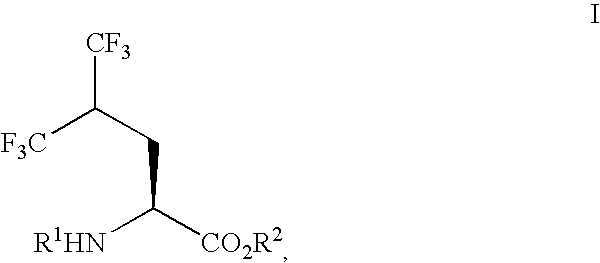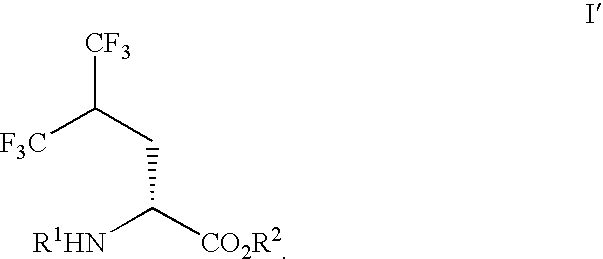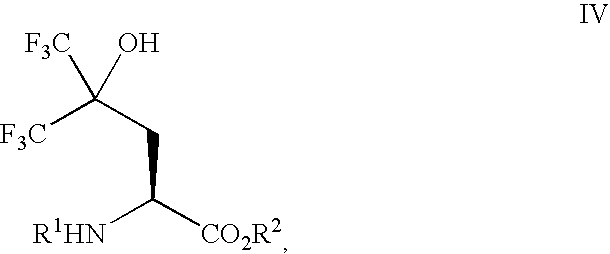Process for preparing single enantiomers of 5,5,5,5',5',5'-hexafluoroleucine and protected analogs
a technology of hexafluoroleucine and enantiomer, which is applied in the direction of biocide, organic chemistry, peptide/protein ingredients, etc., can solve the problem of limiting the value of the route for the production of hfleu for peptide synthesis, difficult to reproduce, and the availability of material whose enantiomeric purity cannot be demonstrated using the method described, etc. problem, to achieve the effect of short and efficient method
- Summary
- Abstract
- Description
- Claims
- Application Information
AI Technical Summary
Benefits of technology
Problems solved by technology
Method used
Image
Examples
example 1
Preparation of 2-benzyloxycarbonylamino-3-hydroxy-propionic Acid Tert-butyl Ester (Formula II, R1=Cbz, R2=tert-butyl)
A mixture of Cbz-L-serine (10.0 g, 42 mmol), benzyltriethylammonium chloride (9.5 g, 42 mmol) and potassium carbonate (38.0 g, 275 mmol) in CH3CN (80 mL) was stirred vigorously for 5 h at RT. 2-Bromo-2-methyl propane was added and the reaction mixture was warmed to 45-50° C. and stirred rapidly. The reaction mixture became very thick after 2-3 h. Additional CH3CN was added (50 mL) to facilitate stirring and the resulting reaction mixture was stirred for 24 h. The reaction mixture was then cooled to RT and most of the CH3CN was removed by rotary evaporation. The reaction mixture was then partitioned between ethyl acetate (200 mL) and water (100 mL). The aqueous layer was extracted with ethyl acetate (3×100 mL). The ethyl acetate layers were combined and washed with water (100 mL), then with sat. aq. NaCl solution (2×100 mL), and then dried over Na2SO4, filtered and c...
example 2
Preparation of 2-benzyloxycarbonylamino-3-iodo-propionic Acid Tert-butyl Ester (Formula III, R1=Cbz, R2=tert-butyl)
Methyltriphenoxyphosphonium iodide ((PhO)3PMeI, 17.09 g, 40 mmol) was added to a DMF (67 mL) solution of 2-benzyloxycarbonylamino-3-hydroxy-propionic acid tert-butyl ester at RT. The resulting solution was stirred at RT for 3.5 h. The reaction mixture was cooled to 0° C. (ice bath) and stirred vigorously. Solid NaHCO3 (10 g) was added followed by the addition of water (20 mL) over a period of 5 min. The reaction mixture was then partitioned between water (250 mL) and 1:1 Et2O-hexanes (250 mL). The aqueous layer was extracted twice with 1:1 Et2O-hexanes (100 mL). The organic layers were combined and washed with aq. NaOH (0.05 M, 200 mL portions) until all of the phenol was removed (as judged by TLC using 35% EtOAc-hexanes). The organic layer was further washed with sat. aq. NaCl (100 mL) and then dried over Na2SO4, filtered, and concentrated. The crude product was puri...
example 3
Preparation of 2-benzyloxycarbonylamino-5,5,5-trifluoro-4-hydroxy-4-trifluoromethyl-pentanoic Acid Tert-butyl Ester (Formula IV, R1=Cbz, R2=Tert-butyl)
Zinc dust (15 g, 230 mmol) in a 3-neck flask (250 mL) was heated under vacuum (1 mmHg) using a heat gun for 5 min (the flask was hot to the touch) and then allowed to cool to RT. The flask was then purged twice with dry nitrogen. Dry DMF (38 mL) was added and the resulting mixture was warmed to ca. 50° C. using a heat gun and stirred vigorously. 1,2-Dibromoethane (1.0 mL, 12 mmol) was added and the resulting mixture was allowed to cool to RT and stirred vigorously for 30 min. Trimethylsilyl chloride (TMS-Cl) (0.3 mL, 2 mmol) was then added and the resulting mixture stirred vigorously for another 30 min. A dry DMF solution (38 mL) of 2-benzyloxycarbonylamino-3-iodo-propionic acid tert-butyl ester (23.21 g, 57 mmol) was then added over a period of 5 min and was consumed after 45 min (TLC, 40% Et2O-hexanes, ninhydrin). In another 3-nec...
PUM
| Property | Measurement | Unit |
|---|---|---|
| Affinity | aaaaa | aaaaa |
Abstract
Description
Claims
Application Information
 Login to View More
Login to View More - R&D
- Intellectual Property
- Life Sciences
- Materials
- Tech Scout
- Unparalleled Data Quality
- Higher Quality Content
- 60% Fewer Hallucinations
Browse by: Latest US Patents, China's latest patents, Technical Efficacy Thesaurus, Application Domain, Technology Topic, Popular Technical Reports.
© 2025 PatSnap. All rights reserved.Legal|Privacy policy|Modern Slavery Act Transparency Statement|Sitemap|About US| Contact US: help@patsnap.com



